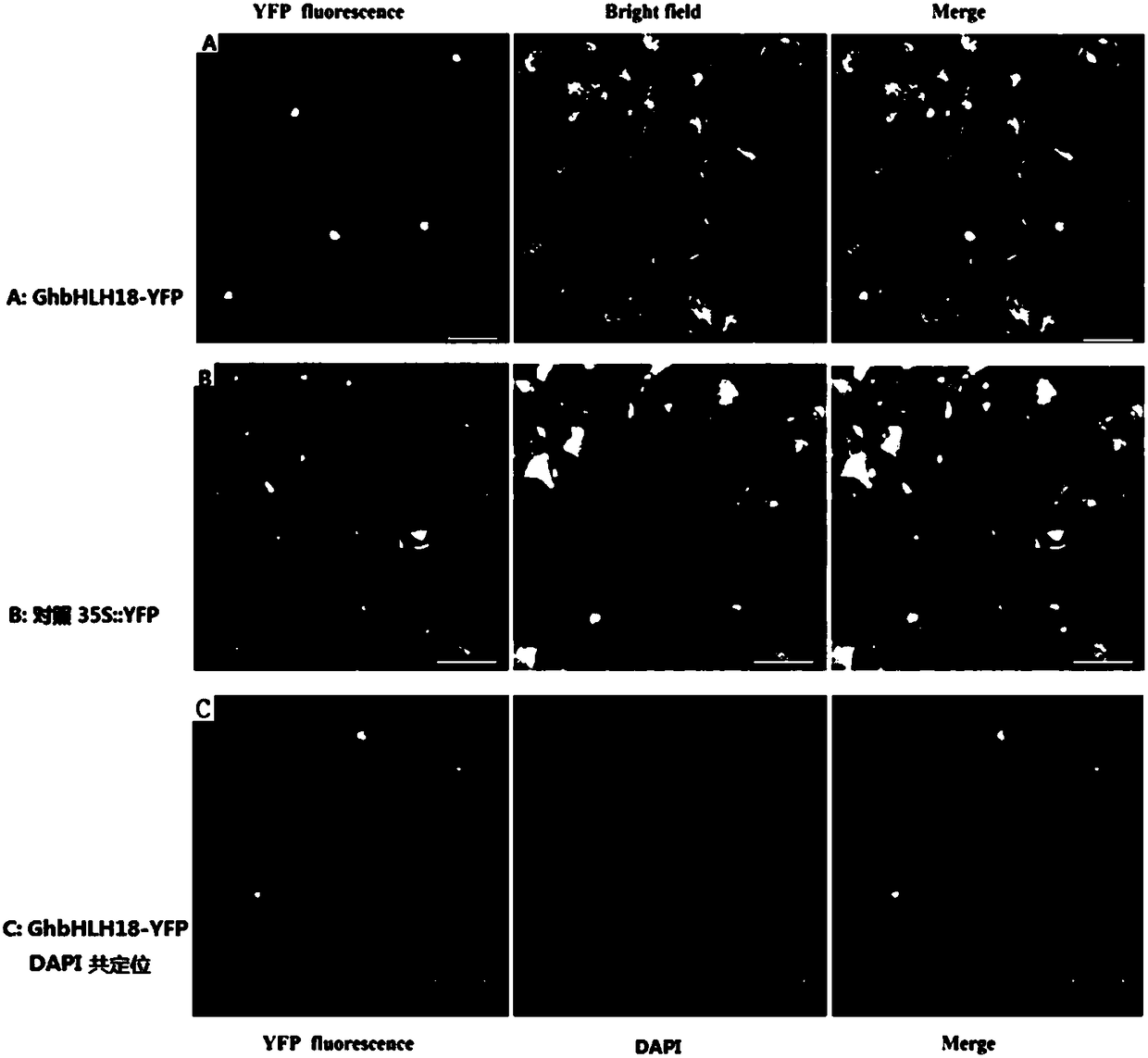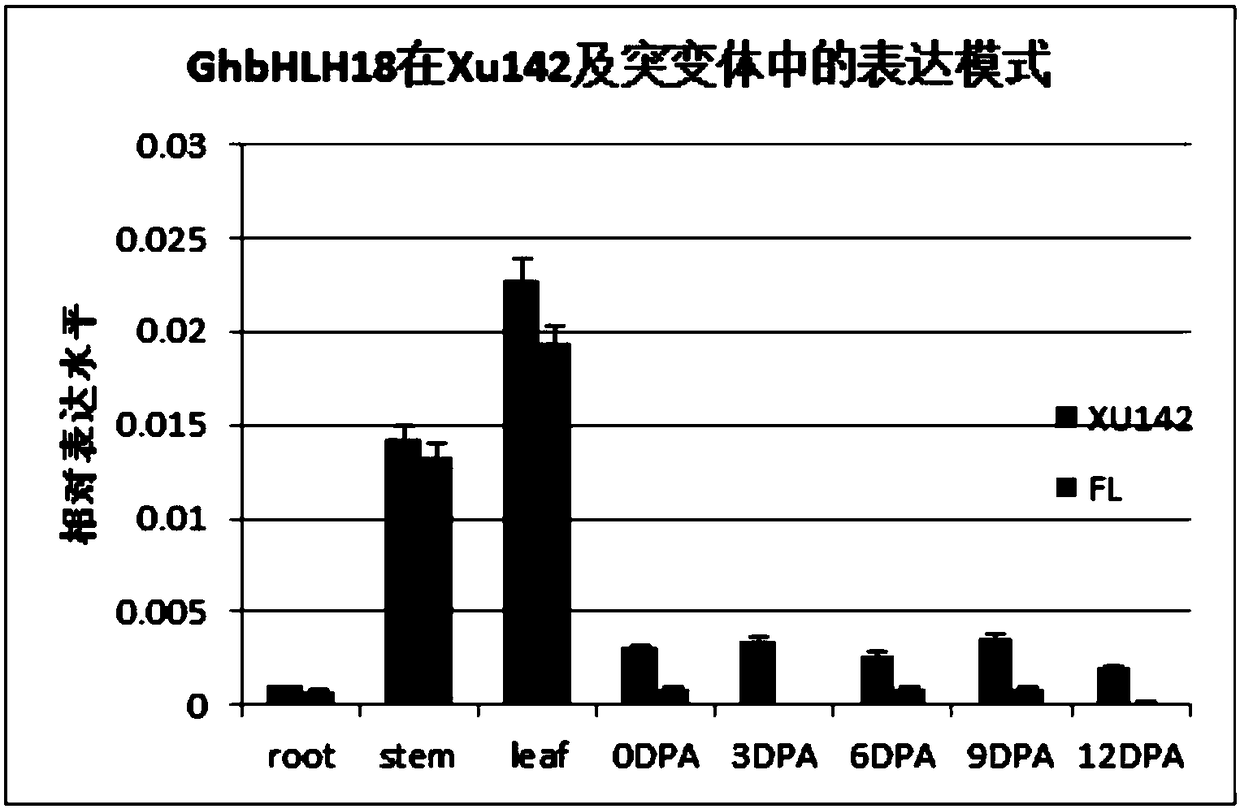Transcription factor GhbHLH18 for expression of elongation period of cotton fibers and application thereof
A transcription factor, cotton technology, applied in the fields of application, genetic engineering, plant gene improvement, etc., to achieve the effect of great application prospects
- Summary
- Abstract
- Description
- Claims
- Application Information
AI Technical Summary
Problems solved by technology
Method used
Image
Examples
Embodiment 1
[0037] Cloning of Example 1 Transcription Factor GhbHLH18
[0038] (1) RNA extraction and inversion of upland cotton (Gossypium hirsutum)
[0039] (1) RNA extraction of upland cotton
[0040] The laboratory uses the CTAB-LiCl method to extract cotton RNA to reduce the impact of secondary metabolites on RNA extraction, and then uses the column method to purify the RNA for subsequent experiments. The following are the specific experimental steps:
[0041] 1) Preparation: pipette tips, tubes, EP tubes, and glass bottles for containing reagents were soaked in 0.1% DEPC water for 8 hours and then autoclaved twice. The mortar, pestle, tweezers, and medicine spoon used in the experiment were baked in a blast drying oven at 150°C for 4 hours.
[0042] 2) Pipette 20mL RNA extraction working solution into a 50mL centrifuge tube, and put it in a 65°C metal water bath to preheat.
[0043] 3) Immediately put the collected experimental sample into a mortar filled with liquid nitrogen,...
Embodiment 2
[0068] Example 2: Construction of the pHELLSGATE12-GhbHLH18 vector by the Getaway method
[0069] (1) Acquisition of gene fragments containing attB linkers
[0070] First, gene primers added with an attB linker are designed, and the nucleotide sequences of the primer pair are shown in SEQ ID NO.4 and SEQ ID NO.5. The fragment recovered in Example 1 was used for PCR amplification with primers added with an attB linker to obtain a gene fragment containing an attB linker. The PCR product is subjected to gel electrophoresis, and the gel is cut and recovered to obtain the fragment obtained by PCR.
[0071] (2) BP reaction construction entry vector
[0072] The entry vector was constructed using BP Clonase from Invitrogrn. The reaction system is as follows:
[0073]
[0074] React at 16°C for 2 hours to construct the entry vector.
[0075] (3) LR reaction constructs interference carrier
[0076] The carrier is pHELLSGATE12vector. The enzyme digestion system is as follows...
Embodiment 3
[0079] Embodiment 3: Obtaining of GhbHLH18 transcription factor RNAi plants
[0080] 1) Transform Agrobacterium with pHELLSGATE12-GhbHLH18 vector
[0081] The interference vector sequenced correctly in Example 2 was selected, and the interference vector was extracted for subsequent Agrobacterium transformation. Similar to transforming E. coli. Take 10 μL of the interfering carrier and add it to 100 μL of Agrobacterium GV3101 competent cells, mix gently and then let stand on ice for 30 minutes. Immediately after liquid nitrogen treatment for 3 minutes, heat shock at 37°C for 10 minutes, followed by ice bathing for 1 to 3 minutes. Add 800 μL LB non-resistance liquid medium, and incubate on a shaker at 180 rpm at 28°C for 3 to 5 hours. After centrifuging at 4000rpm for 3 minutes, discard most of the supernatant, suspend the bacteria and spread evenly on a solid LB resistance plate, incubate at 28°C for 2-3 days.
[0082] The monoclonal bacteria were cultured in the resist...
PUM
 Login to View More
Login to View More Abstract
Description
Claims
Application Information
 Login to View More
Login to View More - R&D Engineer
- R&D Manager
- IP Professional
- Industry Leading Data Capabilities
- Powerful AI technology
- Patent DNA Extraction
Browse by: Latest US Patents, China's latest patents, Technical Efficacy Thesaurus, Application Domain, Technology Topic, Popular Technical Reports.
© 2024 PatSnap. All rights reserved.Legal|Privacy policy|Modern Slavery Act Transparency Statement|Sitemap|About US| Contact US: help@patsnap.com










